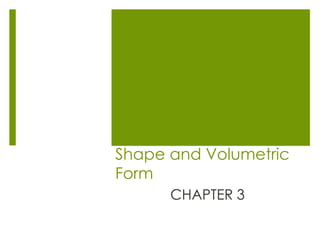Vis. lit. pres2
- 2. Definitions SHAPE ïĄ SHAPE- two dimensional area that displays both width and length; has relatively clear boundaries ïĄ POSITIVE SHAPES- a tangible or solid shape that appears in front of or encloses an area of the background ïĄ NEGATIVE SHAPES- theoretically empty areas created by shapes touching each other ïĄ FIGURE AND GROUND- terms that refer to the interactions of positive and negative shapes in a two dimensional image ïĄ ORGANIC SHAPES- curvilinear in nature, display irregular routines or contours ïĄ GEOMETRIC SHAPES- bordered by straight lines, precise angles, uniform curves VOLUMETRIC FORM ïĄ VOLUMETRIC FORM- three- dimensional equivalent of a two- dimensional shape ïĄ ORGANIC FORMS- display irregular contours, curvilinear and non- mechanical looking ïĄ GEOMETRIC FORMS- cube, sphere, cone or pyramid
- 3. Key Concepts SHAPE and VOLUMETRIC FORM ïĄ Visual conflict contributes to the multi-dimensional character of a portrait. Shapes that are different provide a stimulating effect that add to the aesthetic value of a piece. ïĄ The interaction of organic and geometric shapes and forms show great contrasting visual characteristics as well as visual conflicts and pictorial problems. These appeal to all kinds of people, because different perspectives find beauty in different pieces.. ïĄ Volumetric form is always accompanied by other aspects of the vocabulary of visual expression. (ex. Principle of space) ïĄ Geometric forms and shapes are often seen in architecture because they represent deeper symbolic or religious meanings to different cultures. (ex. Domes on churches)
- 4. References and Connections to PHOTO IDEA INDEX ïĄ Page 100: Shapes âBe on the lookout for interesting and unexpected instances of simple shapes in the real world. If they are intriguing to you, then thereâs a good chance that others will be attracted to the photos you take of them.â ïĄ Page 120: Depth Perception âTake advantage of the intriguing visual and thematic effects that three-dimensional feel can lend to an image. Consider points of view that amplify the perception of depth whenever you sense that such a presentation could enhance an imageâs impact.â ïĄ Page 86: Symmetry âSymmetry, like a basic shape, is easy on the brain: It is a fundamental visual arrangement that does not challenge the viewerâs comprehension.â
- 5. References and Connections to NONDESIGNERS DESIGN BOOK ïĄ Page 81: âDonât be afraid to be asymmetrical, to uncenter your format- it often makes the effect stronger. Itâs okay to do the unexpected.â ïĄ Page 33: âNothing should be placed on the page arbitrarily. Every item should have a visual connection with something else on the page.â Robinâs Principle of Alignment ïĄ Page 33: âThe strength of the edge is what gives strength to the layout.â ïĄ Page 33: âEven when aligned elements are physically separated from each other, there is an invisible line that connects them, both in your eye and in your relationshipâĶâ ïĄ Page 49: âIt is possible to break free of alignment if you do it consciously, and one can tell that it was on purpose.â





